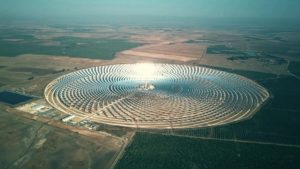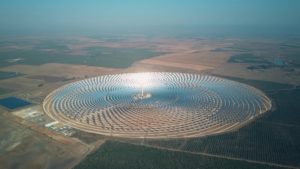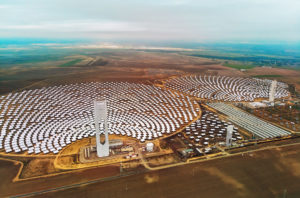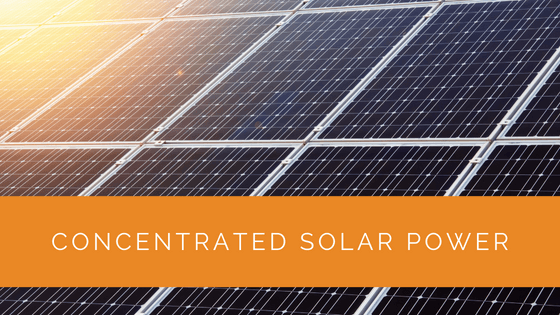Concentrated Solar Power (CSP) represents a remarkable leap in renewable energy technology, harnessing the sun’s boundless energy to generate electricity. This article delves into the fascinating world of CSP systems, exploring their inner workings, the various technologies employed, and their potential impact on our energy landscape. With a focus on clarity and accessibility, we will uncover the advantages, drawbacks, and CSP’s role in our sustainable energy future. Whether you’re a renewable energy enthusiast or simply curious about this innovative technology, join us to understand the power of mirrors and their promise in concentrated solar energy.
Contents
- 1 Key Takeaways
- 2 How Do Concentrated Solar Power Systems Work?
- 3 Benefits of Concentrated Solar Energy
- 4 Drawbacks of Concentrated Solar Power System
- 5 What is the Efficiency of Concentrated Solar Energy?
- 6 Where Does Concentrated Solar Power Come into Play?
- 7 What Role does Concentrated Solar Energy Play in the Future?
- 8 Expert Insights From Our Solar Panel Installers About Concentrated Solar Power
- 9 Discover the Power of Solar with Solar Panels Network
- 10 Conclusion
Key Takeaways
- Concentrated Solar Power (CSP) uses mirrors to focus and convert natural sunlight into electricity through heat and steam, making it a versatile and sustainable energy source.
- CSP technology offers benefits such as consistent energy supply, potential for hybrid power facilities, and the ability to contribute to a more reliable energy grid while reducing carbon emissions.
- However, CSP systems also have drawbacks, including high water usage, cost of operation, competition from other renewable energy sources, and the need for ongoing technological advancements for greater efficiency.
How Do Concentrated Solar Power Systems Work?
CSP systems concentrate the sun’s solar power upon a receiver, transforming it into heat. The heat is subsequently turned to steam, which powers a turbine that generates electricity.
CSP plants can use thermal energy storage systems to store thermal energy until it is needed, such as during periods of low sunlight. CSP is a versatile, clean, renewable energy source because of its space to store heat energy.
Combining CSP systems with other power sources could create hybrid power facilities. CSP, for instance, can be combined alongside a thermal power block that burns coal, non-renewable fuels, or biofuels.

Four categories of CSP Technology
Parabolic Trough Systems: Solar power is condensed via bent, trough-shaped mirrors directed upon a receiving pipe in a parabolic dish system. The pipe typically holds heated thermal oil before being utilised in a solar steam engine thermal power block to generate electricity.
Power Tower Systems: This power tower system follows the sun and then directs its power onto a receptor at the top of a building using heliostat reflectors. A fluid is boiled and utilised within the transmitter to generate steam that powers a turbine connected to a generator.
Linear Fresnel Systems: Many sensors are arranged in a linear Fresnel system. The parabolic reflectors are set firmly on the floor, focusing sunlight onto the recipient tube above them. Fresnel can include reserves in a power plant or produce steam effectively, analogous to troughs and power towers.
Systems for Parabolic Dishes: A parabolic-shaped trough is a collector reflecting solar power upon a receiver installed on a building with solar reactors. A heat engine then generates the accumulated heat. The dish can reach incredibly high temperatures, making the technology suitable for solar thermal energy reactors.
Benefits of Concentrated Solar Energy
Here’s a look at a few advantages of Concentrating solar energy.
- The fact that CSP is inexhaustible is by far the most crucial benefit. Its supply would never run out and can be used indefinitely, making it a long-term renewable energy source. It also cuts down on carbon emissions and has the potential to enhance air quality while also slowing global warming and climate change.
- In contrast to solar photovoltaics (PV) and wind power, which can provide inconsistent supply, CSP offers an essential constant source of the sun’s energy. The electrical energy produced by CSP facilities is the efficient and reliable power source that is retained in the matter of salt solutions.
- Conventional solar power plants can readily be converted to CSP. CSP technologies can be employed in vehicles that run on fossil fuels. As construction and operation are simpler, CSP technology has lower production costs over nuclear and hydrocarbon-based facilities.
- Concentrated solar power plants can combine various energy sources to create a more reliable energy grid. CSP can assist in satisfying future electricity demand if it is included in the electricity sector. It can also help with oil recovery by concentrating heavy crude, so it’s simpler to pump with the heat it produces.
- CSP can be utilised as a portable energy source. For example, the international renewable energy agency Ecofys conducted research to verify the potential of the CSP system as a technique for producing cost-effective fuel that may be utilised to power automobiles.

Drawbacks of Concentrated Solar Power System
Despite its many advantages, CSP plants have several drawbacks. For starters, a lot depends on where you are. Like solar PV and wind energy, CSP plants require considerable space to operate, making them economically unviable in densely populated areas. Here are some more demerits to this power system.
- Water is used extensively in solar thermal power to operate steam turbines and chill thermochemical units. Although saltwater may appear viable, it may cause problems with solar radiation in the nearby region. The sunlight from CSP plants can draw animals, and the temperature can be lethal to some species.
- A solar power CSP is very costly to operate. Materials for heat storage that can resist extreme heat are expensive and hard to come by. It has a limited operational range since molten salt hardens at relatively low temperatures and decays at intense heat.
- CSP does not consistently achieve the expansion to become a primary fuel because of competition from other renewable energy like nuclear fission and solar PV power.
- Concentrated solar power may become outdated as discoveries in other fields continue to generate better electrical power.
What is the Efficiency of Concentrated Solar Energy?
The effectiveness of a concentrated solar power CSP plant is affected by several things. The sort of commercial operation, the heat transfer fluid, and the flat mirrors all contribute to the efficiency of a concentrated solar power system.
However, most CSP plant installations generate power between 7 and 25 per cent.
Hydropower systems can improve efficiency by up to 90%, while a steam turbine can reach energy savings of up to 59 per cent. The performances of solar photovoltaic panels are comparable to that of concentrated solar power systems, with many of these photovoltaic panels attaining around 14 and 23 per cent efficiency.

Where Does Concentrated Solar Power Come into Play?
Global CSP installations have increased over the years.
Spain is home to the world’s largest CSP plants, accounting for over 42 per cent of all CSP installations and power generation. The PS10 (Planta Solar 10) in Spain was among the earliest commercial utility-scale projects also utilising flat mirror strips. By a ten-year infrastructure plan, the country expects to quadruple its CSP output to 4.8 GW by 2025.
The Ouarzazate Solar Power Station, which has a potential of 510MW, is currently the most popular CSP system. It comprises three plants and began operations in 2016, employing the parabolic trough technique.
Around 1.1 million middle-east Moroccans rely on it for electricity.
On the other hand, the Moroccan plant is set to fall behind Noor Energy 1, a 700MW CSP plant in Dubai that is now under development. The project, which will combine parabolic trough and power tower technology, will not be completed until 2022. However, it will be part of Dubai’s ‘Vision 2022’ strategy to assure sustainable and ecologically friendly development.
The United States is also recognised because of its CSP operations, with 52 in operation, the largest of which is the 392MW Ivanpah installation in California. However, no new CSP initiatives have been announced in the United States since 2016.
What Role does Concentrated Solar Energy Play in the Future?
While the worldwide solar business has grown rapidly in recent years, the advent of solar energy has had a significant influence. Globally, there are around 130 CSP installations with a cumulative installed capacity of 5,500 MW.
While CSP rates are cheaper than ever, concentrated solar power still faces several hurdles. For starters, CSP plants are costly to build, have significant operating expenses, and have scarce money for new and upcoming projects.
However, as the CSP distribution network develops and financiers see the potential of CSP, it might bring down costs, and the future of concentrated solar will begin to look brighter.
According to the International Energy Agency, CO2 will have to be deleted from the atmosphere by the turn of the era to keep the earth’s temperature under 2 degrees. Concentrated solar power appears to have a promising future in helping to reduce carbon dioxide emissions.
Energy specialists investigate whether CO2 can be taken first from the air and eliminated using amino acid chemistry.
Climeworks, a direct wind capture firm, has invented a carbon removal technique that utilises moderate flame as a power source to absorb atmospheric carbon with the filter.
Expert Insights From Our Solar Panel Installers About Concentrated Solar Power
Concentrated Solar Power (CSP) represents a significant advancement in harnessing solar energy. By using mirrors to focus sunlight, CSP systems can generate substantial amounts of electricity, offering a stable and consistent energy source. The technology’s potential for thermal energy storage further enhances its capability to provide power even when the sun isn’t shining.
Renewable Energy Specialist
CSP has the unique advantage of being able to integrate with conventional power plants, which can utilise fossil fuels or biofuels, to form hybrid systems. This flexibility makes CSP an attractive option for transitioning to cleaner energy sources while maintaining grid stability.
Environmental Engineer
While CSP systems are promising, their high initial costs and water usage are significant challenges. However, as the technology matures and becomes more efficient, we can expect these barriers to decrease, making CSP a more viable option for large-scale renewable energy production.
Energy Policy Analyst
Discover the Power of Solar with Solar Panels Network
Are you navigating the world of solar installations? Look no further than Solar Panels Network, the UK’s trusted partner in harnessing the sun’s potential. Our dedication goes beyond just installations; we’re on a mission to transform how homeowners and businesses across the UK perceive and utilise energy. By choosing us, you’re reducing your carbon footprint and making a smart financial move that promises savings for years ahead. Contact us today and embark on your solar journey.
Conclusion
To sum it up, mirrors are used in Concentrating Solar Power (CSP) systems to concentrate the sun’s radiation energy and transform it into heat, which is then used to spin a turbine, which creates electricity.
This article covered all you need to know about concentrated solar power plants, including how they function and their advantages and disadvantages. You can easily discuss this futuristic energy power source and maybe invest in one.
About the Author
Solar Panels Network stands at the forefront of solar energy solutions, driven by a team of seasoned solar engineers and energy consultants. With over decades of experience in delivering high-quality solar installations and maintenance, we are committed to promoting sustainable energy through customer-centric, tailored solutions. Our articles reflect this commitment, crafted collaboratively by experts to provide accurate, up-to-date insights into solar technology, ensuring our readers are well-informed and empowered in their solar energy decisions.

